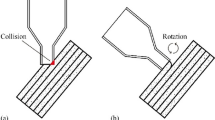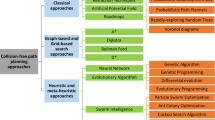Abstract
Several studies have investigated the properties of the workspace of opened chain robotics with the purpose of emphasizing their geometric and kinematic characteristics to devise analytical algorithms and procedures for their design. The workspace of a manipulator robot is considered of great interest from a theoretical and practical viewpoint. In this paper, the workspace topology is defined by the number of kinematic solutions, the number of cusps and nodes that appear on the workspace boundary. In this work, a multiobjective optimization problem is formulated with the aim of obtaining the optimal geometric parameters of robot, which must obey the topology specified by the designer. The maximum workspace volume, the maximum system stiffness and the optimum dexterity are considered as multiobjective functions. In addition, the optimization problem is subject to penalties that control the topology, forcing it to occupy a certain portion of the workspace. In this study, a computational tool, called Improved Differential Evolution with parallel processing, is developed using the concept of evolution shuffled sets. Moreover, three different metaheuristics are applied to obtain the problem solution. Five robotic applications are presented to show the efficiency of the proposed methodology.











Similar content being viewed by others
References
Abdel-Malek K, Yeh HJ, Othman S (2000) Understanding Voids in the Workspace of Serial Robot Manipulators, Proceedings Pf 23rd ASME, Design Engineering Technical Conference, Baltimore, Maryland
Angeles J (ed) (2003) Fundamentals of robotics mechanical systems, ed 2. Theory, Methods and Algorithmas, Springer
Baili M (2004) Analyse et classification de manipulateur 3R axes orthogonaux. Thèse de Doctorat - University of Nantes, France
Bandyopadhyay S, Saha S, Maulik U, Deb K (2008) A simulated annealing-based multiobjective optimization algorithm: AMOSA, IEEE trans. on Evolutionary Computation
Bergamaschi PR, Nogueira AC, Saramago SFP (2006) Design and optimization of 3R manipulators using the workspace features. Appl Math Comput Elsevier 172(1):439–463
Bergamaschi PR, Saramago SFP, Coelho LS (2008) Comparative study of SQP and metaheuristics for robotic manipulator design. Appl Numer Math 58:1396–1412
Bujok P (2011) Parallel models of adaptive differential evolution based on migration process. Aplimat J Appl Math 4:2
Ceccarelli M (1996) A formulation for the workspace boundary of general N-revolute manipulators. IFToMM J Mech Mach Theory 31(5):637–646
Ceccarelli M, Lanni C (2004) A multi-objective optimum design of general 3R manipulators for prescribed workspace limits. Mech Mach Theory 39:119–132
Ceccarelli M (2004) Fundamentals of mechanics of robotic manipulation. Kluwer, Dordrecht
Chong CK, Mohamad MS, Deris S, Shamsir MS, W, Choon YW, Chai LE (2012) Improved differential evolution algorithm for parameter estimation to improve the production of biochemical pathway. Int J Interact Multimed Artif Intell Spec Issue Distr Comput Artif Intell 1: 22–29
Company O, Pierrot F, Fauroux JC (2005) A method for modeling analytical stiffness of a lower mobility parallel manipulator. In: Proceeding Of IEEE ICRA: Int. Conf. On Robotics and Automation, Barcelona 18–25 Apr 2005
Corvez S, Rouillier F (2002) Using computer algebra tools to classify serial manipulators. Proceeding Fourth International Workshop on Automated Deduction in Geometry, Lins
Das S, Konar A, Chakraborty UK (2005) Two improved differential evolution schemes for faster global search, In GECCO’05. ACM, Washington, DC
Deblaise D, Hernot X, Maurine P (2006) A systematic analytical method for PKM stiffness matrix calculation. IEEE International Conference on Robotics and Automation
Duan QA, Gupta VK, Sorooshian S (1993) A parallel differential evolution algorithm. J Optim Theory Appl 76:3
El-Khasawneh BS, Ferreira PM (1999) Computation of stiffness and stiffness bounds for parallel link manipulator. Int. J. Mach Tools Manuf 39(2):321–342
Houck CR, Joinez JA, Kay MG (1985) A genetic algorithms for function optimization: a matlab implementation. NCSO-IE Technical Report, University of North Caroline, USA
Deb K (2001) Multiobjective Optimization Using Evolutionary Algorithms. Wiley, New York
Khalil W, Dombre E (1999) Modlisation Identification et Commande des Robots, 2me dition revue et augmente. Herms, Paris
Kwedlo W, Bandurski K (2006) A parallel differential evolution algorithm. In: Parallel Computing in Electrical Engineering, PAR ELEC
Lee E, Mavroidis C (2002) Solving the geometric design problem of spatial 3R robot manipulators using polynomial homotopy continuation. J Mech Des 124:652–661
Li R, Xu L, Shi XW, Zhanh N, Lv ZQ (2011) Improved differential evolution strategy for antenna array pattern synthesis problems. Prog Electromagn Res 113:429–441
Mehablia A (2010) An improved differential evolution algorithm and its application in reaction kinetic parameters estimation. In: European Conference of Chemical Engineering
Nocedal J, Wright SJ (2000) Numerical optimization, Springer Series in Operations Research
Oliveira LS, Saramago, SFP (2010) Multiobjective optimization techniques applied to engineering problems. J Braz Soc Mech Sci Eng XXXII: 94–104
Ottaviano E, Ceccarelli M, Husty M (2007) Workspace topologies of industrial 3R manipulators. Int J Adv Robot Syst 4(3):355–364
Paul RP, Stevenson CN (1983) Kinematics of robot wrists. Int J Robot Res 2(1):31–38
Rivin EI (1999) Stiffness and damping in mechanical design. Marcel Dekker Inc., New York
Saramago SFP, Ottaviano E, Ceccarelli M (2002) A characterization of the workspace boundary of three-revolute manipulators, design engineering technical conferences (DETC-02). In: Proceedings of DETC-02, ASME 2002, Montreal, vol 1, pp 34342–34352
Tasoulis DK, Pavlidis NG, Plagianakos VP, Vrahatis MN (2004) Parallel differential evolution. In: Congress on Evolutionary Computation, pp. 2023–2029
Vinogradov IB, Kobrinski AE, Stepanenko YE, Tives LT (1971) Details of kinematics of manipulators with the method of volumes (in Russian). Mekhanika Mashin 27–28:5–16
Wenger P, Omri ElJ (1996) Changing posture for cuspidal robot manipulators. In: Proc. Int. Conf. on Robotics and Automation, Philadelphia, pp 3173–3178
Yang DC, Lai ZC (1985) On the conditioning of robotic manipulators-service angle. ASME J Mech Transm Auto Des 107:262–270
Yoshikawa T (1985) Manipulability of robotic mechanisms. Int J Robot Res 4(2):3–9
Acknowledgments
The authors acknowledge the Fundação de Amparo a Pesquisa do Estado de Minas Gerais (FAPEMIG) for the financial support.
Author information
Authors and Affiliations
Corresponding author
Additional information
Technical Editor: Glauco A. de P. Caurin.
Rights and permissions
About this article
Cite this article
Brandão, M.A.L., Oliveira, G.T.S., Saramago, S.F.P. et al. Using metaheuristics for optimum design of 3R orthogonal manipulators considering their topology. J Braz. Soc. Mech. Sci. Eng. 37, 1701–1718 (2015). https://doi.org/10.1007/s40430-014-0298-9
Received:
Accepted:
Published:
Issue Date:
DOI: https://doi.org/10.1007/s40430-014-0298-9




